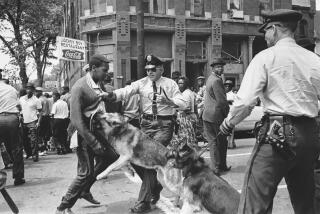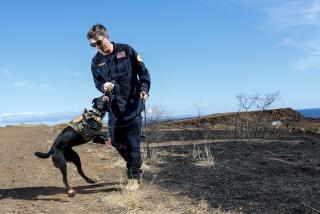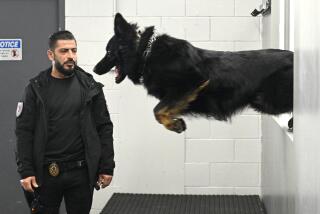Bloodhounds Put Noses to Grindstone
- Share via
BITTINGER, Md. — Scott Brothers pushed the wrinkled face of his bloodhound to the ground to sniff human scent off a cigarette dropped by a suspected Peeping Tom.
“Go find him, buddy,” shouted Brothers, a bloodhound handler and special deputy from Juniata County, Pa.
Nose to the ground, the slobbering black-and-tan bloodhound began romping through the woods of Deep Creek Lake State Park so fast that Brothers had to run to keep up. His tugs on a 30-foot leash went unnoticed by the dog that was hot on the trail of the assailant--really Kent Robey, another police bloodhound handler from Campbell County, Va.
Robey and Brothers were among 80 police dog handlers with 60 bloodhounds who were in this western Maryland town recently to practice and refine their man-tracking skills deep in the woods and along busy city streets.
About half a mile down the trail, the dog found Robey sitting inside a bright yellow construction backhoe, protected from the sleet and freezing temperatures.
“Show him to me. Show him to me,” Brothers said as the dog, named Micky, pranced around the backhoe. “Good boy. Get him out of there.”
This is the sixth year that the National Police Bloodhound Assn. has held its weeklong training school at a cluster of cabins near Bittinger in Garrett County.
The association, founded in 1962, has nearly 350 members who conduct 2,000 to 3,000 searches a year. There are an estimated 300 other bloodhound handlers in the United States who do not belong to the association.
“You’re on call 24 hours a day. You chase people who no one else wants to chase,” said Lenny Millholland, an investigator with the Winchester, Va., police department. “While their ears are flopping against the leaves, their noses work like a vacuum cleaner, pulling up the scent.”
Bloodhounds, known for their red-rimmed, sad eyes, sagging jowls and wrinkled foreheads, can begin tracking when they are just weeks old. Some dogs work more than 12 years tracking escapees, criminals, lost children and elderly people, including those with Alzheimer’s disease.
They can follow a human scent for miles.
“People see them on ‘Hee Haw,’ and they think they are lazy dogs,” said Sgt. Ron Brown, with the sheriff’s department in nearby Allegany County. “They are not lazy at all. They’ll run you to death.”
The dogs often begin their work by sniffing clothing worn by the person being tracked. The bloodhounds also can pick up a scent from car or bicycle seats, key rings or wallets--anything the person has touched.
Body scent should not be confused with body odor, said Andrew J. Rebmann, a retired Connecticut State Police trooper who handled bloodhounds for 18 years. The human body continually sheds millions of microscopic cells. It is believed that bacteria interact with the cells and produce a gas. Each gaseous odor is unique, like a fingerprint.
A light rain can enhance a scent, while a heavy rain can wash it away or confuse the bloodhound. Wind might scatter the cells, and temperature can affect the intensity of the scent, Rebmann said.
“I pulled more than a few miracles out of my bag,” he said. “The dog did it. I just followed the dog.”
There are more trained bloodhounds working for law enforcement agencies now than in the 1940s, when prison guards began using the dogs’ keen sense of smell to find escapees, said Wayne Krieger of Cattaraugus County, N.Y., who is president of the association.
But in recent years, financial problems at law enforcement agencies have left some bloodhound programs out of budgets. Police administrators sometimes tend to favor the German shepherd, which can be trained to sniff for drugs, bombs, do building searches and attack work.
“The bloodhound can do one thing. They are the best man-trailing dogs in the world,” Brown said. “The budget crunch will get the bloodhound before the shepherd. For the money, many police departments want a utility dog.”
More to Read
Sign up for Essential California
The most important California stories and recommendations in your inbox every morning.
You may occasionally receive promotional content from the Los Angeles Times.













